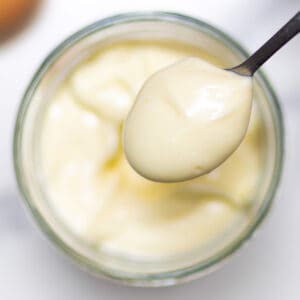
Fail-Proof Homemade Mayonnaise Without Mustard
This Homemade Mayonnaise without Mustard recipe is quick and simple. Only 4 ingredients and takes 10 minutes to prepare!
Print Recipe
Pin Recipe
Servings: 1 jar
Calories: 2.475kcal
Equipment
- 1 hand blender
INGREDIENTS
- 1 egg
- 1 ¼ cup sunflower oil
- 1 teaspoon lemon juice
- 2 teaspoon white vinegar
- ½ teaspoon salt
INSTRUCTIONS
- Egg should be added to a small food processor bowl and processed for 20 seconds. Add salt and vinegar. 20 more seconds are spent processing.
- After cleaning the bowl's sides and bottom, switch on the food processor, and start adding the oil carefully, a little at a time, until about a quarter of it has been added (this is critical for proper emulsification).
- You can relax your rules a bit after you see that the mixture is starting to thicken and emulsify. Continue adding it gradually while the processor is running, but increase the amount to a very thin stream rather than drips of oil.
- After adding all the oil, scrape the bowl's bottom and sides, then process for an additional 10 seconds. Once the mayonnaise has been properly seasoned, add salt, lemon juice, or additional vinegar as desired.
- Remember to gradually feed in extra oil while the processor is running if the mayo seems too thin.
NOTES
- Homemade mayonnaise can be kept for up to a week in the refrigerator when covered.
- Choose fresh, well-refrigerated, clean grade A or AA eggs with undamaged shells when picking raw eggs for homemade mayonnaise.
- Olive oil: Olive oil can be a touch overbearing, so choose one that is light and fruity. You might also choose to use olive oil for only half of the recipe's oil calls for it and something more neutral for the other half.
- Fixing Broken Mayonnaise: Although we have never experienced a recipe for mayonnaise breaking on you, don't worry! You ought to be able to resolve the issue.
- Note that this recipe calls for no mustard and no water added! don't be afraid just follow the steps and everything is going to be just okay and you'll get the perfect mayonnaise you wanted.
NUTRITION
Calories: 2.475kcal | Carbohydrates: 1g | Protein: 6g | Fat: 277g | Saturated Fat: 28g | Polyunsaturated Fat: 11g | Monounsaturated Fat: 230g | Trans Fat: 0.02g | Cholesterol: 164mg | Sodium: 1.225mg | Potassium: 66mg | Fiber: 0.01g | Sugar: 0.3g | Vitamin A: 238IU | Vitamin C: 2mg | Calcium: 26mg | Iron: 1mg
DID YOU MAKE THIS RECIPE?Follow @ambitiousfoodieblog on Instagram, take a shot, and tag it #ambitiousfoodieblog! I love to see what you are making!